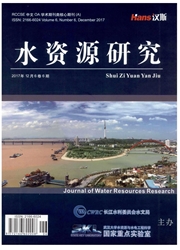

 中文摘要:
中文摘要:
本文采用汉江流域13个气象站1961~2014年逐日气象数据(降雨、温度、相对湿度、日照时数和风速),利用标准化降水指数(SPI)和标准化降水蒸散指数(SPEI)两个干旱指标,分析了1961~2014年汉江流域的干旱变化特征。结果表明:(1)近54年来,汉江流域年降水量呈不显著下降趋势,年参照蒸发量呈显著减少趋势(-7.7 mm/10a),SPI指数总体上呈不显著下降趋势,而SPEI指数呈不显著上升趋势;(2)1个月尺度的SPI指数的正负波动范围较SPEI大,随着时间尺度延长,SPI/SPEI发生干旱的持续时间增长,旱涝变化趋于稳定;(3)流域无旱的累积概率超过65%,随时间尺度延长无旱发生的概率逐渐降低;(4)流域最干旱的年份为1966年,最干旱年东南地区的干旱等级整体上比西北地区高,最湿润年为1983年,SPI/SPEI由西北向东南均呈现先减小再增大的趋势;在描述各站点干旱等级时,最干旱年SPEI描述的流域干旱等级整体上高于SPI,最湿润年SPI和SPEI描述的旱涝等级基本一致。
 英文摘要:
英文摘要:
To analyze the characteristics of drought variations in Hanjiang Basin, the standardized precipitation index (SPI) and the standardized precipitation evapotranspiration index (SPEI) were calculated by using daily me- teorological data {including precipitation, temperature, relative humidity, solar duration and wind speed) from 13 meteorological stations across Hanjiang Basin for 1961-2014. Results showed that: [1) in the past 54 years, the annual precipitation showed a non-significant downward trend, while the annual evapotranspira- tion presented a significant downward trend {-7.7 mm/10 a); the SPI index demonstrated a non-significant downward trend, and the SPEI index with a non-significant upward trend; (2) SPI values with 1-month scale had a larger fluctuation range than SPEI values, and the SPI/SPEI drought duration extended as the time scale prolong; (3) over 65% of the basin was drought-free in 1961-2014, and the drought-free cumulative proba- bility decreased as time scale extended; {4) the driest year in Hanjiang Basin was 1966, with higher drought grade in southeast region than in northwest region overall, while the 1983 was the wettest year, with SPI/SPEI values decreased and then increased from northwest to southeast~ When describing the drought grade at each station, drought grades based on SPEI were higher than SPI as a whole in the driest year, while drought grades based on SPI and SPEI were basically consistent in the wettest year in Hanjiang Basin.
 同期刊论文项目
同期刊论文项目
 同项目期刊论文
同项目期刊论文
 期刊信息
期刊信息
